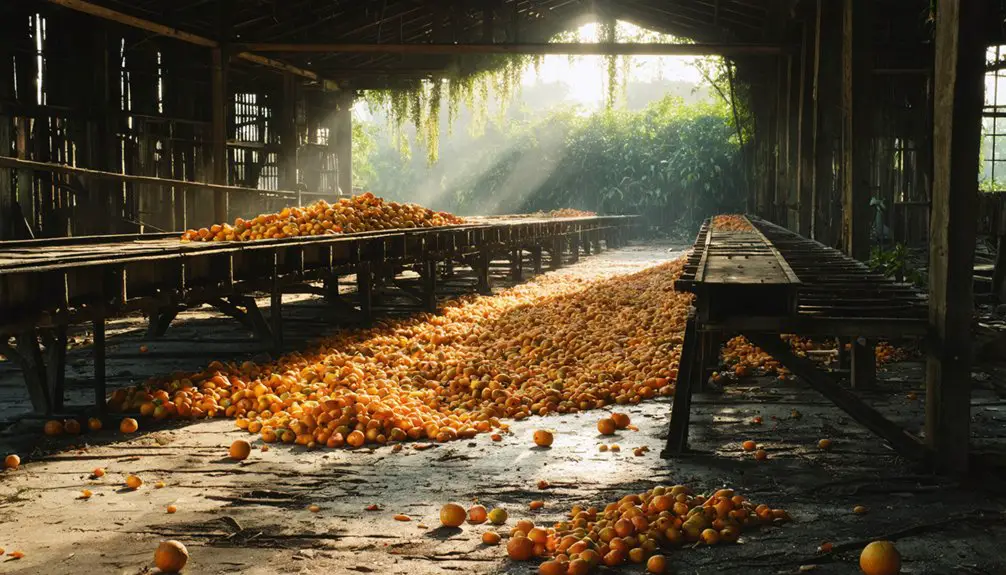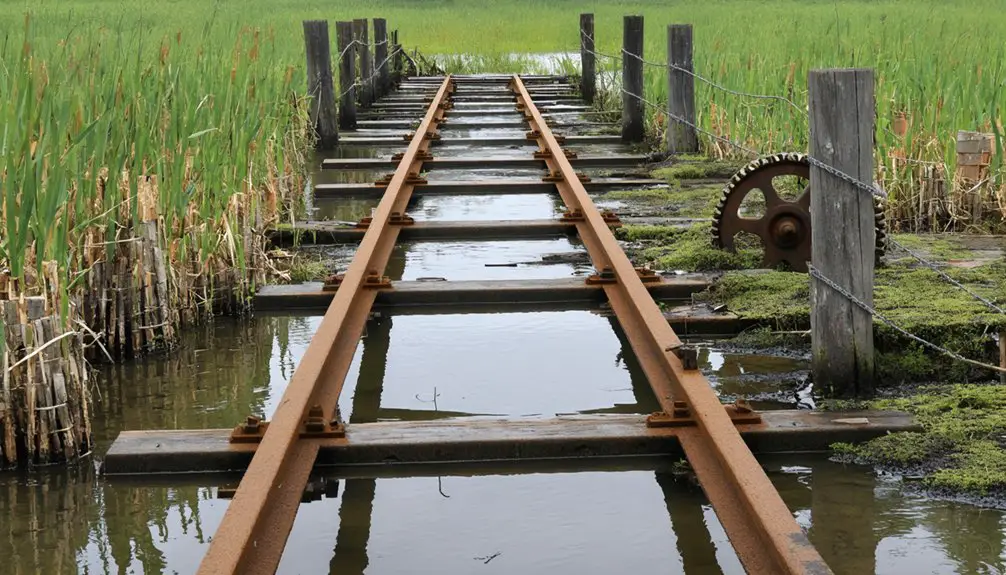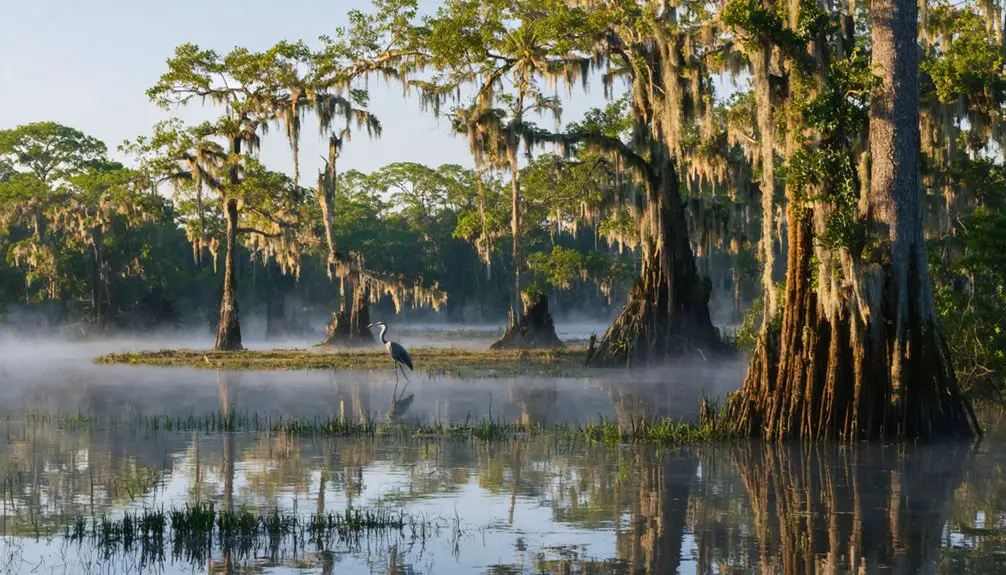You’ll find Deep Lake, a natural limestone sinkhole in Florida’s Everglades, as the centerpiece of a former agricultural boomtown. In the early 1900s, the site transformed from Seminole territory into a thriving grapefruit operation with its own railroad line. Despite shipping 17,000 boxes annually by 1915, the community couldn’t survive the combined pressures of the Great Depression, harsh freezes, and challenging subtropical conditions. The abandoned town’s ruins now lie hidden beneath aggressive vegetation, while its depths hold preserved archaeological treasures.
Key Takeaways
- Deep Lake became a ghost town after its grapefruit industry collapsed in the early 1940s due to economic pressures and labor costs.
- The community’s isolation deepened when railroads bypassed the area, forcing reliance on outdated stagecoach transportation routes.
- Aggressive subtropical vegetation reclaimed abandoned buildings and infrastructure, creating hazardous conditions throughout the settlement.
- The site originated as a successful grapefruit operation in the early 1900s, shipping 17,000 boxes annually by 1915.
- Natural challenges, including sinkholes, extreme weather, and infrastructure degradation, contributed to the settlement’s ultimate abandonment.
The Natural Sinkhole Lake’s Unique Features
As groundwater slowly dissolves Florida’s limestone bedrock, Deep Lake stands as one of the state’s most remarkable sinkhole formations.
You’ll find this natural wonder characterized by its steep-walled basin and cylindrical shape, created when underground cavities collapsed after years of limestone dissolution.
The lake’s unique structure supports impressive ecological diversity, with distinct vegetation zones ranging from hardwood forests at the rim to specialized wetland plants along the water’s edge.
You’ll notice how the lake’s depth and chemical composition, rich in dissolved carbonates, create microhabitats that harbor species you won’t typically see in surrounding areas.
The lake’s connection to the local water table means you’re witnessing a dynamic system that continues to evolve through ongoing geological processes of erosion and sedimentation.
Early Seminole Settlements and Conflict
While Deep Lake’s limestone basin tells a geological story, its surroundings chronicle a rich Native American heritage spanning over 14,000 years.
The area’s elevated terrain near Deep Lake became particularly significant during the Seminole Wars, as Native Americans sought defensible positions against U.S. military forces. You’ll find that early Seminole settlements in this region weren’t random – they strategically chose this location for its natural protection and abundant resources. The Spanish initially labeled these native inhabitants as cimarrónes, misrepresenting their diverse cultural identity. After fleeing persecution and conflict, Muscogee Creek Indians formed the foundation of what would become the Seminole nation in Florida.
As land conflicts intensified following the Treaty of Moultrie Creek in 1823, Deep Lake’s surrounding territory became essential for Seminole resistance.
The region’s challenging terrain, with its dense vegetation and water access, provided tactical advantages during their guerrilla warfare campaigns, allowing them to maintain their independence longer than many other Native American groups in Florida.
Pioneering Agriculture in the Everglades
During the early twentieth century, agricultural pioneers transformed the Everglades’ wetlands into productive farmland through an ambitious drainage and land reclamation project.
You’ll find that farming first took root in 1913 along Lake Okeechobee’s natural levees, as early settlers discovered the surrounding sawgrass plains weren’t yet suitable for cultivation.
The creation of the Everglades Agricultural Area in 1948 marked a turning point in Everglades agriculture.
The 1948 establishment of the Everglades Agricultural Area revolutionized farming in South Florida’s wetlands, transforming the region’s agricultural potential.
Through extensive canal networks and strategic water management, farmers overcame flooding challenges and soil deficiencies. By adding manganese sulfate and copper to the muck soil, they successfully cultivated diverse crops including sugarcane, vegetables, and rice.
Initial proposals to drain the Everglades for agriculture began in 1848, though significant development wouldn’t occur for several more decades.
Hamilton Disston’s 4 million acre purchase in 1881 initiated the first major attempt to drain and develop the region for farming.
The Belle Glade Experiment Station played a significant role in crop adaptation, helping farmers solve cultivation challenges in this unique landscape.
The Deep Lake Railroad Era
If you’d ventured along the Deep Lake Railroad‘s construction path in 1913, you’d have encountered workers struggling against the dense Everglades vegetation and swampy terrain to lay track through some of Florida’s most challenging landscapes.
The railroad’s builders had to contend with extreme heat, humidity, and the constant encroachment of sawgrass while maintaining the rails through flood-prone areas of the Big Cypress Swamp. The original purpose of the rail line was to transport grapefruit to market from the ambitious ranch development.
After years of development, the Atlantic Coast Line Railroad acquired Deep Lake Railroad and extended operations to reach Everglades City by 1928.
Railroad Construction Challenges
Because the Deep Lake railroad project cut through the unforgiving Everglades terrain, construction crews faced extraordinary challenges in establishing a viable rail line. Similar to the slave labor crews that built Florida’s first cross-state railroad in 1855, workers endured grueling conditions to complete the tracks. The project faced difficulties comparable to those of the Key West extension, which cost $50 million to construct.
You’d find laborers battling dense sawgrass and forest vegetation while contending with treacherous sinkholes, including a notorious 90-foot chasm near Deep Lake itself. Labor safety remained precarious as workers confronted swarms of insects, wild animals, and the region’s oppressive heat and humidity.
The engineering techniques required to overcome these obstacles were remarkable. Crews had to clear wilderness, build embankments through marshland, and develop specialized foundation methods to prevent track subsidence.
With limited mechanization, they relied heavily on manual labor, sometimes taking nearly a year to complete just 10 miles of track through the inhospitable landscape.
Decline and Final Closure
While the Deep Lake Railroad enjoyed a period of prosperity throughout the 1920s and early 1930s under Barron Collier‘s leadership, its decline accelerated rapidly by the latter part of the decade.
The rise of car culture in Florida during this era further diminished the railroad’s importance as a transportation option. The digital preservation of historical records helps document this pivotal transition period in Deep Lake’s history.
You’ll find that several factors contributed to this transportation evolution, including rising labor costs and the devastating effects of the Great Depression.
The death of Barron Collier dealt another significant blow to the railroad’s operations.
Grapefruit Industry’s Rise and Fall

Shortly after 1900, Walter Langford and John Roach acquired Deep Lake with ambitious plans to establish a thriving grapefruit enterprise. Their grapefruit cultivation efforts transformed 200 acres into productive groves of Marsh seedless trees, marking an economic resurgence for the region.
You’ll find that by 1915, the operation was shipping 17,000 boxes annually, utilizing an innovative rail tram system for transport.
When Barron Collier purchased Deep Lake in 1922, he expanded operations and infrastructure, leading to the Atlantic Coast Line Railroad’s integration in 1928.
However, the prosperity wouldn’t last. Rising labor costs and diminishing profits during the Great Depression strained the business. Despite its early success, the grapefruit industry couldn’t sustain itself, ultimately closing in the early 1940s and leaving Deep Lake’s ambitious agricultural dreams behind.
Environmental Challenges and Natural Obstacles
The subtropical climate of Deep Lake’s Everglades setting brought intense summer downpours and periodic hurricanes that repeatedly damaged the grapefruit groves and settlement infrastructure.
You’ll find evidence of nature’s dominance in the aggressive vegetation, including saw palmettos and scrub pines, which rapidly overtook abandoned buildings and roads throughout the area.
The region’s environmental challenges extended beyond weather, as the limestone bedrock’s tendency to form sinkholes – like Deep Lake itself – created ongoing structural instability that complicated long-term settlement efforts.
Harsh Everglades Weather Patterns
Situated within Florida’s subtropical climate zone, Deep Lake endured extreme weather patterns that posed significant challenges for its inhabitants.
You’d find yourself battling intense heat stress during summer months, with temperatures soaring into the 90s and humidity exceeding 90%. The wet season’s afternoon thunderstorms brought relentless lightning hazards from May through October, making outdoor activities treacherous.
During winter, you’d experience brief respites with temperatures dropping into the 50s, though rare cold fronts could plunge readings to near-freezing.
The area’s annual rainfall, concentrated heavily in June, would’ve regularly exceeded 9 inches per month, creating persistent muddy conditions and water-level fluctuations.
These harsh conditions particularly challenged transportation and construction efforts, while the combination of heat, humidity, and frequent storms made daily life in Deep Lake especially demanding.
Flooding and Agricultural Impact
Despite its fertile soil and agricultural promise, Deep Lake’s location in the Lake Okeechobee basin made it exceptionally vulnerable to catastrophic flooding.
You’ll find that flood management efforts, including drainage canals and levees, consistently failed against the region’s brutal storm surges, particularly during the devastating 1928 Okeechobee hurricane that sent water levels soaring 20 feet higher than normal.
The area’s agricultural resilience was severely tested as floodwaters repeatedly destroyed crops and infrastructure.
While the muck soil proved excellent for farming, it’d quickly erode during floods, filling drainage canals with silt.
Rail lines you’d need for transporting crops to market suffered frequent damage, and the cycling pattern of destruction forced many farmworkers to abandon their livelihoods, contributing to Deep Lake’s eventual ghost town status.
Rapid Vegetation Overtakes Infrastructure
Once Deep Lake’s infrastructure fell into disuse, subtropical vegetation launched an aggressive reclamation of the abandoned settlement.
You’ll find dense sawgrass and tropical plants completely overwhelming the deteriorating structures, while thick mats of vines accelerate the corrosion of exposed metal components. The region’s hot, humid climate and limestone bedrock create perfect conditions for year-round vegetation encroachment, making it nearly impossible to maintain clear access to the site.
Root systems have invaded the soil beneath foundations, leading to widespread infrastructure degradation.
The karst landscape‘s sinkholes and uneven terrain create isolated pockets where moisture accumulates, fostering impenetrable growth.
You’ll encounter hazardous conditions as natural succession transforms the once-cleared land, with native hardwoods and palms establishing dominance over the ruins of Deep Lake’s past.
The Town’s Economic Decline
When harsh winter freezes struck Deep Lake in 1894 and 1895, they triggered a catastrophic chain of economic events that would ultimately seal the town’s fate.
Without economic resilience strategies in place, the devastation of citrus groves sparked widespread community migration patterns as farmers and their families sought opportunities elsewhere.
You’ll find Deep Lake’s decline accelerated as railroads bypassed the town, leaving it reliant on outdated stagecoach routes.
The town’s isolation deepened when nearby communities with rail access drew commerce away, while rising labor costs and management challenges in the 1930s further strained its fragile economy.
Remnants and Archaeological Findings

While Deep Lake’s commercial importance faded into history, the site’s archaeological significance has emerged through remarkable underwater discoveries.
You’ll find evidence of prehistoric practices spanning thousands of years, including Native American burial sites over 7,200 years old preserved in the lake’s peat-bottomed depths. The sinkhole formation, reaching depths of 90 feet, has created perfect conditions for preserving organic materials rarely found elsewhere.
What’s particularly fascinating are the remains of extinct megafauna, including mastodons and prehistoric horses, showing clear signs of human interaction through cut marks and nearby stone tools.
Ancient hunters left their mark on history through cut marks on mastodon bones and stone tools found alongside prehistoric horse remains.
The lake’s stratified sediments have yielded Archaic period artifacts and ceramics, while its anaerobic environment has preserved wooden tools and textiles that tell a rich story of Florida’s earliest inhabitants.
Present-Day Conservation and Access
Today, Deep Lake stands as an essential component of Southwest Florida’s expansive conservation network, where coordinated efforts between public and private entities protect its unique ecological value.
Through the Green Heart of the Everglades initiative, you’ll find stringent protections against development and resource extraction, ensuring the lake’s preservation for future generations.
Conservation strategies now focus on maintaining crucial hydrological connections between Deep Lake and surrounding Everglades watersheds.
While public access has increased, you’ll discover carefully managed recreational opportunities that protect sensitive ecosystems. You can explore designated hiking trails and wildlife observation areas, guided by informative signage.
Conservation Florida, working alongside federal and state agencies, continues to expand protected areas through strategic land acquisitions and partnerships with private landowners, creating a lasting natural legacy.
Frequently Asked Questions
Were There Any Notable Crimes or Mysterious Incidents in Deep Lake?
You won’t find documented ghost sightings or unsolved mysteries here – historical records show no notable crimes in the area beyond the broader regional conflicts during the Third Seminole War.
What Happened to the Residents After They Abandoned the Town?
When push came to shove, you’d find residents scattered to nearby towns like Everglades City. They’d sold their grapefruit farms, sought work elsewhere, and integrated into Florida’s expanding communities post-1940s.
Did Any Other Industries Attempt to Establish Themselves After Grapefruit Farming?
You won’t find evidence of other industries taking root after grapefruit’s decline. Neither citrus processing facilities nor tourism potential materialized, as the area transformed directly into a nature preserve by the 1970s.
Were There Any Schools or Churches Built in Deep Lake?
You won’t find any school history or church architecture in the records – there’s no evidence that either type of building was constructed during the settlement’s brief existence as a farming outpost.
How Many People Lived in Deep Lake During Its Peak Population?
Like scattered seeds in a vast field, you’d find that this ghost town’s demographics were sparse, with peak population estimates suggesting no more than 100-200 people during its agricultural heyday.
References
- http://www.gribblenation.org/2018/07/florida-friday-deep-lake-and-harrisburg.html
- https://thesunshinerepublic.com/2025/02/19/floridas-forgotten-railroads-the-ghost-tracks-that-once-connected-the-state/
- https://www.nps.gov/bicy/learn/historyculture/deep-lake.htm
- https://www.tiktok.com/@socialshepherdadventures/video/7342301852702100778
- https://www.ghosttowns.com/states/fl/deeplake.html
- https://www.fnai.org/PDFs/NC/Sinkhole.pdf
- https://fl.water.usgs.gov/PDF_files/cir1182_tihansky.pdf
- https://pubs.usgs.gov/of/2000/0294/report.pdf
- https://floridadep.gov/fgs/sinkholes/content/sinkhole-faq
- https://flshmp-floridadisaster.hub.arcgis.com/pages/sinkhole



